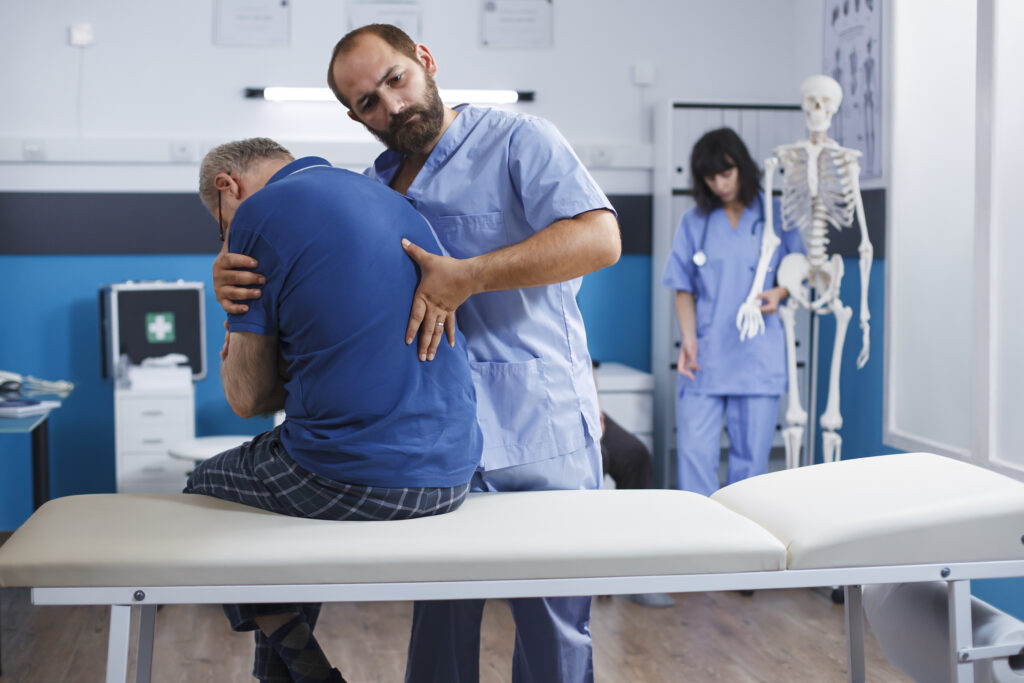You might not realize how small, gentle adjustments can greatly enhance mobility for seniors. By focusing on simple changes—like stretches, ergonomic furniture, and tailored exercises—you can help improve flexibility and confidence. These tweaks not only reduce pain but also empower seniors to participate more fully in daily life. Imagine the impact of these adjustments on their independence and emotional well-being. What specific strategies can you implement to create a more supportive environment?
Importance of Senior Mobility
When it comes to aging, maintaining mobility is fundamental for seniors. Staying active not only enhances physical health but also boosts mental well-being. You'll find that regular movement helps improve circulation, strengthens muscles, and maintains joint flexibility. This isn't just about staying fit; it's about preserving your independence and quality of life.
Having good mobility makes daily tasks easier. You can enjoy simple activities like walking in the park, visiting friends, or even grocery shopping without relying on others. When you're able to move freely, you're more likely to engage in social interactions, which can combat feelings of loneliness and isolation.
Moreover, staying mobile plays a significant role in preventing falls, a common concern among seniors. When you maintain your strength and balance, you're less likely to experience accidents that could lead to serious injuries. This proactive approach to mobility not only keeps you safe but also gives you confidence in your ability to navigate your environment.
Additionally, mobility contributes to a sense of purpose. Whether it's taking a dance class or participating in community events, being active allows you to pursue hobbies and interests that bring you joy.
In essence, prioritizing mobility is about embracing your golden years with energy and confidence. By focusing on maintaining movement, you're investing in your future, ensuring that each day is filled with opportunities for engagement and fulfillment.
Common Mobility Challenges
Many seniors face various mobility challenges that can hinder their daily activities and overall quality of life. As you age, you might notice a decline in strength, balance, and flexibility, making simple tasks feel intimidating. You might struggle with walking, climbing stairs, or getting in and out of a chair. These challenges can stem from a range of issues, including arthritis, muscle weakness, or even the side effects of medication.
Another common issue is joint pain, which can make movement uncomfortable or even painful. You may find yourself avoiding certain activities you once enjoyed, leading to a more sedentary lifestyle. This can create a cycle of decreased mobility and increased discomfort.
Fear of falling is also a significant concern; this fear can prevent you from engaging in social activities or even participating in daily routines.
You might notice that your vision or hearing has declined as well, which can further complicate mobility. Difficulty in perceiving depth or hearing important environmental cues can increase your risk of accidents. Additionally, using mobility aids like canes or walkers can sometimes feel awkward or uncomfortable, which might deter you from using them consistently.
Lastly, psychological factors such as anxiety or depression can exacerbate mobility challenges. If you feel isolated or overwhelmed, it can be harder to stay active.
Recognizing these common mobility challenges is the first step toward finding solutions that work for you.
Benefits of Gentle Adjustments
Gentle adjustments can greatly enhance your mobility and flexibility, making daily activities easier.
You'll likely notice reduced pain and discomfort, allowing you to enjoy life more fully.
Embracing these adjustments can lead to a more active and fulfilling lifestyle.
Enhanced Mobility and Flexibility
Choosing gentle adjustments can greatly enhance your mobility and flexibility, allowing you to move with greater ease and comfort. These adjustments focus on your body's natural alignment, promoting better range of motion in your joints. As you experience increased flexibility, everyday activities like bending, reaching, and walking become less challenging.
When your body is well-aligned, it can respond more effectively to movement demands. You'll likely find that you can participate in activities you once enjoyed, whether it's gardening, playing with grandchildren, or simply taking a stroll in the park.
Gentle adjustments help to release tension held in muscles and connective tissues, which can tighten over time. Moreover, these adjustments can improve your posture, further contributing to your overall mobility.
By encouraging proper alignment, you'll feel more balanced and stable, reducing the risk of falls. This newfound confidence in your physical abilities can empower you to explore new activities and maintain an active lifestyle.
Incorporating gentle adjustments into your routine can lead to significant improvements in how you move, enhancing your overall quality of life. You'll not only feel better physically but also enjoy the freedom that comes with increased mobility and flexibility.
Reduced Pain and Discomfort
Experience a remarkable reduction in pain and discomfort through gentle adjustments that focus on your body's specific needs. These adjustments target areas of tension and misalignment, helping to alleviate pressure on nerves and muscles. By addressing underlying issues, you can enjoy a more comfortable daily life.
Gentle adjustments can help relieve chronic pain conditions such as arthritis, sciatica, or back pain. Unlike more invasive treatments, these techniques are designed to be gentle and supportive, minimizing the risk of further injury. You may find that as your discomfort decreases, your overall mobility improves, allowing you to engage in activities you love.
Additionally, gentle adjustments promote better circulation and reduce inflammation, which can greatly contribute to pain relief. This holistic approach not only helps you feel better physically but also enhances your emotional well-being. You'll likely notice improved sleep patterns and reduced stress levels as your pain diminishes.
Incorporating gentle adjustments into your routine can lead to lasting benefits, helping you maintain an active lifestyle. Prioritizing your comfort and health is essential, and gentle adjustments offer an effective pathway to reducing pain, paving the way for greater mobility and enjoyment in your life.
Effective Exercises for Seniors
When it comes to staying active, safe stretching techniques are essential for seniors.
Incorporating balance and stability exercises into your routine can greatly enhance your mobility and confidence.
Let's explore some effective ways to keep you moving safely and steadily.
Safe Stretching Techniques
As you age, incorporating safe stretching techniques into your routine can greatly enhance your flexibility and overall well-being. Stretching helps maintain muscle elasticity and joint health, which is vital for daily activities.
Start with gentle stretches that don't push your limits. Warm up with light movements, like walking in place, to prepare your muscles.
One effective stretch is the seated hamstring stretch. While sitting, extend one leg out and keep the other bent. Reach toward your toes, feeling a gentle pull in the back of your thigh. Hold for 15-30 seconds, then switch legs.
Another great option is the shoulder stretch. Bring one arm across your chest and hold it with your opposite hand. This helps relieve tension and improves upper body flexibility. Hold for 15-30 seconds before switching sides.
Always remember to breathe deeply during stretches; this helps you relax and enhances the stretch. Never force a stretch; listen to your body and stop if you feel pain.
Aim to stretch at least three times a week to reap the benefits. With these safe techniques, you'll support your mobility and maintain your independence as you age.
Balance and Stability Exercises
Maintaining balance and stability is essential for seniors to prevent falls and enhance daily activities. Incorporating balance exercises into your routine can markedly improve your overall mobility and confidence.
Here are four effective exercises you can try:
- Single-Leg Stand: Stand on one leg for 10-30 seconds. Switch legs and repeat. This strengthens your ankles and improves coordination.
- Heel-to-Toe Walk: Walk in a straight line, placing the heel of one foot directly in front of the toes of the other. This exercise challenges your balance and promotes stability.
- Chair Stand: Sit in a chair and stand up without using your hands. Sit back down and repeat. This builds leg strength and enhances your ability to rise from a seated position.
- Side Leg Raises: Stand next to a wall or sturdy chair for support. Lift one leg straight out to the side, hold for a moment, and lower it back down. This strengthens your hip muscles and improves balance.
Incorporating these exercises into your daily routine can provide you with a sense of security and independence, allowing you to enjoy life to the fullest.
Ergonomic Home Modifications
Creating a comfortable and safe living environment is essential for seniors, and ergonomic home modifications play an important role in achieving this. By making thoughtful adjustments to your home, you can enhance your mobility and reduce the risk of injury.
Start by evaluating high-traffic areas. Make certain that walkways are clear and free from clutter, which can trip you up. Consider adding non-slip mats in areas like the kitchen and bathroom to provide extra grip.
Next, focus on your furniture. Opt for chairs and tables that are at a comfortable height. When you sit down, your feet should rest flat on the floor, and your knees should be at a right angle. You might also want to invest in a recliner or adjustable chair that offers better support and comfort.
In the kitchen, simplify your workflow. Place frequently used items within easy reach, and consider using pull-out shelves or lazy Susans to minimize bending and reaching.
Install grab bars in the bathroom to assist with shifting in and out of the shower or tub.
Don't forget about lighting. Make certain that all areas of your home are well-lit, as poor visibility can lead to accidents. Use motion-sensor lights in hallways and bathrooms for added convenience.
Finally, think about your bedroom. Keep essential items like glasses or a phone within arm's reach and make certain your bed is at a height that allows for easy access.
These ergonomic modifications will make a significant difference in your daily life, promoting both safety and independence.
Seeking Professional Guidance
Sometimes, maneuvering the complexities of senior mobility adjustments can feel overwhelming, but seeking professional guidance can make a significant difference. Engaging experts like occupational therapists or physical therapists enables you to receive tailored advice that addresses individual needs.
These professionals understand the nuances of mobility issues and can recommend practical solutions that enhance safety and independence.
Here are some reasons why professional guidance is vital:
- Personalized Assessments: Experts evaluate your unique situation, taking into account medical history, physical capabilities, and environmental factors. This tailored approach guarantees that recommendations genuinely fit your lifestyle.
- Expert Knowledge: Professionals have extensive training and experience in mobility solutions. They can offer insights into the latest tools and techniques that can vastly improve your mobility and quality of life.
- Preventative Strategies: By identifying potential risks and offering preventative measures, professionals help you avoid falls and injuries. This proactive approach is essential for maintaining long-term independence.
- Emotional Support: Adjusting to mobility changes can be emotionally taxing. Professionals not only provide practical solutions but also offer encouragement and understanding, helping you navigate the emotional aspects of these adjustments.
Involving a professional in your mobility journey can lead to significant improvements in both your physical capabilities and emotional well-being.
Don't hesitate to reach out for help; it's a step toward a more empowered and fulfilling life.
Conclusion
Incorporating gentle adjustments into your daily routine can dramatically enhance your mobility and quality of life. By addressing common challenges and embracing targeted exercises and ergonomic changes, you'll feel more confident and independent. Remember, seeking professional guidance tailored to your unique needs can make a world of difference. Embrace these strategies to not only improve your physical well-being but also to foster emotional health, leading to a more active and fulfilling lifestyle. You deserve it!




